Guineas may be new to you but they are not to author and researcher Christine Heinrichs. These beautiful birds still exist in the wild in Africa but have also been domesticated for a small flocks. Learn how to get started raising guineas.
What are guinea fowl?
Guinea fowl are birds from the family Numididae and order Galliformes. They are poultry-type birds raised mainly for their meat. Contemporary domestic breeds originated from wild birds in West Africa. As insect eaters, they have recently become more popular to control ticks and other insects in Europe and north America. As domestic birds, they are sometimes kept in lieu of chickens as they won’t tear up your garden as quickly.

Helmeted guinea fowl and keets. (Photo by Joanne, Adobe)
They have a small, featherless head on a skinny neck, topping a sturdy round body with dark grey or blackish plumage. Guineas average 16-28 inches tall (40-71 cm) and weigh between 1-4 pounds (700-1600 grams); the hens are larger than the cocks. Their legs are short but can carry these birds long distances. For instance, they can range more than six miles in a day in the wild.
Their wings are short but wide and strong making them good fliers. They can easily clear a 6-foot fence, so you need to consider using bird mesh over their enclosure to keep them in.
Many of the species of guinea fowl are monogamous, mating for life, or are serially monogamous, though the Kenya crested guinea fowl are reported to be polygamous in captivity. In the wild, they often travel behind herd animals, or live beneath monkey troops, eating grubs from their manure.
Listen to their calls and enjoy other guinea fowl videos on GuineaFowlTV
Why Keep Guineas
Guineas are unique and ancient birds. Their distinctive (and loud) screech serves as both commentary on available food bits, and the arrival of predators. Dr. N.W. Sanborn wrote in the April 1912 issue of American Poultry Advocate “It looks fierce and half crazy, and is still more queer in its cry.” While their cry may annoy your neighbors, R.H. Hastings Bleshaw, in his 1985 book “Guinea Fowl of the World” describes their constant chatter as “A running commentary on the nature of food” which “will fetch other guineas from many yards away to share the delicacy.”
Domesticated guineas in the U.S. are usually kept in relatively small numbers and often with a chicken flock. Guineas serve as an excellent warning system, especially of air born predators. These highly social birds also eat a wide variety of annoying insects such as ticks, mosquitoes and wasps.
There are several nicknames for domestic guinea fowl: pintades, pearl hens or gleanies; and the young are called “keets”. Their high protein (and delicious eggs) are laid 25-30 at a time, are smaller than chicken eggs (larger than quail eggs), dark and have thick shells.
While these birds were quite popular in Victorian England, they didn’t catch on as well in the U.S. until recently. Many recent city, county or state ordinances that have allowed for backyard/urban poultry include guinea fowl. They are a great addition to both your flock and your table.
A Palette of Colors and Use
Stunning Plumage
Today’s domesticated guineas are raised in at least 30 different colors and patterns, from the traditional pearl gray to unusual pinto, white feathers with some pearl gray spotting. The spots are called pearls and the color palette ranges across subtle shades of ivory, lavender and brown.

Lavender guinea fowl strutting on lawn. (Adobe image)
Guinea Farm in New Vienna, Iowa offers 30, including Royal Purple, Coral Blue, and Buff Dundotte. Pied birds have white patches in otherwise colored plumage.
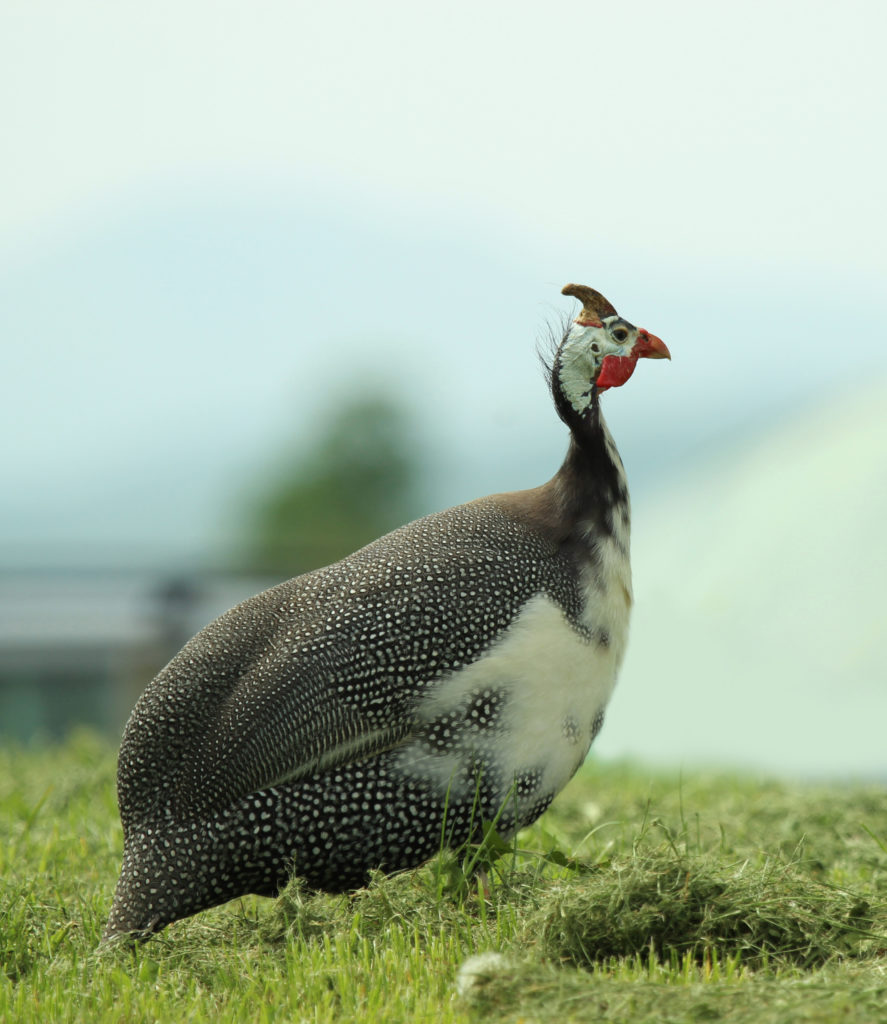
Pie or splashed guinea fowl.
Guineas and Poultry Shows
You may get your first view of guinea fowl on exhibit at a local or state fair poultry show. The original Pearl, White and Lavender are the only colors recognized by the American Poultry Association’s Standard of Perfection for exhibition. Weight is a breed characteristic when guineas are judged. Exhibition weights are from three to four lbs. Underweight and overweight birds lose points or can even be disqualified if they are more than 20 percent too big or too small.
Sexing Guineas
Males and females look so much alike that even experienced keepers have trouble telling them apart. Males may develop larger wattles and females have a more stooped stance, but both these qualities are relative and may not be trustworthy indicators of sex. The most reliable way is their call. Males make a single syllable “Chit-chit-chit” noise while females use two syllables, described as “buck-wheat, buck-wheat” or “come back, come back”. Some start making this call as early as six weeks old, but others may not start calling until they are older. And because guineas are capricious birds, sometimes, the females choose to imitate the male call. To sex you birds with some reliability, look for a blend of physical characteristics and calls.
Small flock fancier Dale Westman, who lives in a rural area southwest of Seattle, has kept guineas since he was a boy. He’s attuned to the differences between male and female guineas and relies on a combination of their calls and the wattles, the gills on the side of the face.
“Males have a gill so big, it loops forward and looks like a cup, cupping your ear,” he said. “Females have gills that are small and close to the head.”
One guinea owner came to him concerned that the guineas she had kept for a year had not laid any eggs. He saw that they were all males. He sent her home with two females and only one of her males.
Getting started
Eggs or Keets, Keets or Eggs?
Matt Mensen, who raises about 3,500 guineas annually with his wife Maria on their Iowa Guinea Farm, sells about 60,000 keets a year in 30 color varieties. He recommends starting with keets rather than hatching eggs or mature birds.
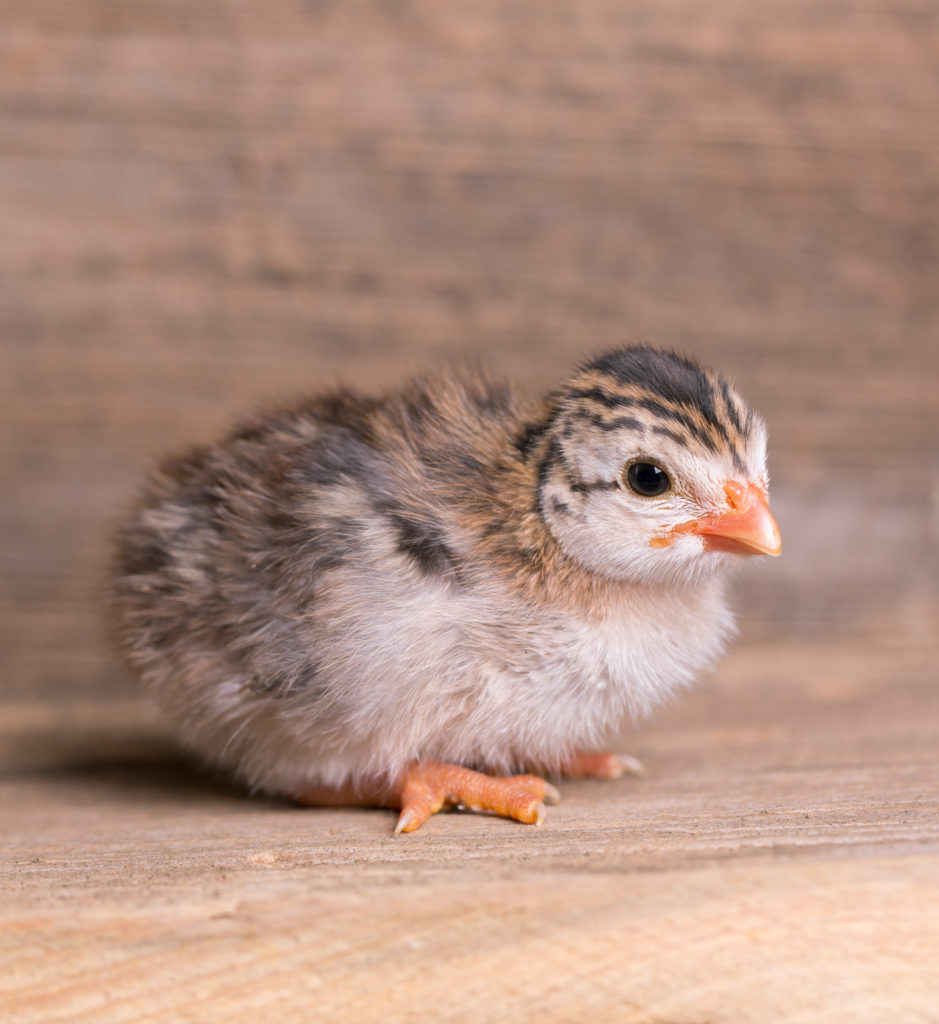
Guinea fowl keet
“If you start with keets, they will know where home is,” he said. “If you buy older ones, they may fly away.
Westman, who currently keeps about 50 guineas, also finds buyers are more successful with keets. He notes that some guinea owners report that their guineas came with the property when they bought it. They simply won’t leave.
Hatching eggs are fussier to pack and ship than keets are. If you want to start with hatching eggs, best to find a local breeder and pick the eggs up at the farm. A chicken hen can hatch the eggs, but the incubation period is 26 days, longer than chickens’ 21 days. Most hens don’t mind setting a few days longer. Guinea eggs have thick shells and are difficult to candle to check for fertility and embryo development.
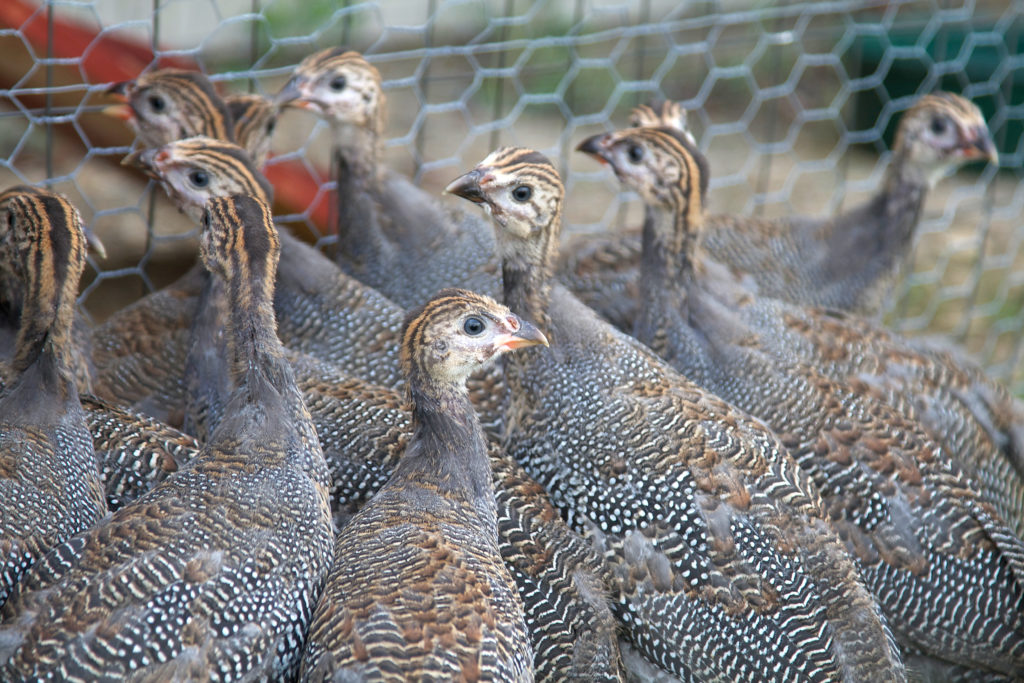
Six-week old keets
Westman lets the guinea hen hatch the eggs, but then takes the keets away from her to be raised in a brooder or by a chicken hen. Although guinea mothers are ferocious defenders of the whole flock, they aren’t very effective mothers, and keets often don’t survive. His keets stay in the brooder for at least eight weeks and have a heat lamp available for 12 weeks or longer, depending on whether it’s a cold time of year.
Pinioning or Not?
Many keepers prefer to pinion (clip) their guineas’ wings, a practice acceptable in showing guineas at American Poultry Association shows. Pinioning is clipping the last joint off the keet’s wing, where the primary flight feathers grow. The joint never grows back, making it impossible for the bird to fly.
Matt Mensen’s Guinea farm offers pinioning for an extra charge but doesn’t recommend this if your birds are going to free range. And guineas really like to free range, sometimes traveling several miles a day, without coming back to roost in the nice coop you made for them. They need to fly to escape from predators.
Guinea husbandry
Adult guineas like hot weather but are tough enough to survive in colder climates. They are also tolerant of drought, gleaning moisture from their food (grubs and bugs). Some species of wild guinea fowl such as the vulturine, have been known to go for days without drinking water. But remember that the young birds are much more sensitive to weather changes, especially cold temperatures. Mensen at Guinea Farm raises all his guineas indoors, not just to provide temperature control, but also to limit bug problems such as gnats nibbling at young guinea eyes.
How to Feed Guineas
Keets benefit from game bird starter, with its higher protein content than chick feed. Penned guineas do well on chicken layer feed. As they prepare for laying season, they can benefit from higher protein feed such as turkey starter or gamebird feed, starting in February. Adult guineas that free range will find plenty of their own food, like those ticks they are popular for eating. They will also eat fleas, flies, mosquitos, beetles, wasps, termites, cutworms, grubs, worms, snails, snakes, mice, and small rats.
Westman lets his guineas free range during good weather, from March until it gets cold and snowy. Guinea males and females bond, sometimes as couples, sometimes with one male and a harem of three or four hens.
“If I don’t let them out during the day, they can’t pick and choose the mate that they want,” he said. “The bigger, older males are the bosses.”
“Some people have them as house pets,” Westman said, “not that I’d have them in my house. Depending on how you raise them, they can be very loyal to you.”
You can try attracting them with treats, such as scratch grain or worms, so they will come to the coop to be locked in at night. If left out, guineas will roost in trees or on rooftops at night, but they will be more vulnerable to predators. Westman lost two guineas and two chickens to a bald eagle before the flock got wise to her.
“That was a beautiful bird,” he said, “but not so beautiful to me.”
Guinea products
Guinea Meat
The popularity of guineas on the dinner table has waxed and waned over the centuries, but meat variety is on the rise as more people worldwide are returning to raising their own food and investing in ancient and heritage breeds. As guinea fowl usually hatch May through November, you should plan ahead to harvest them at 14 weeks when they have good growth and tender meat.
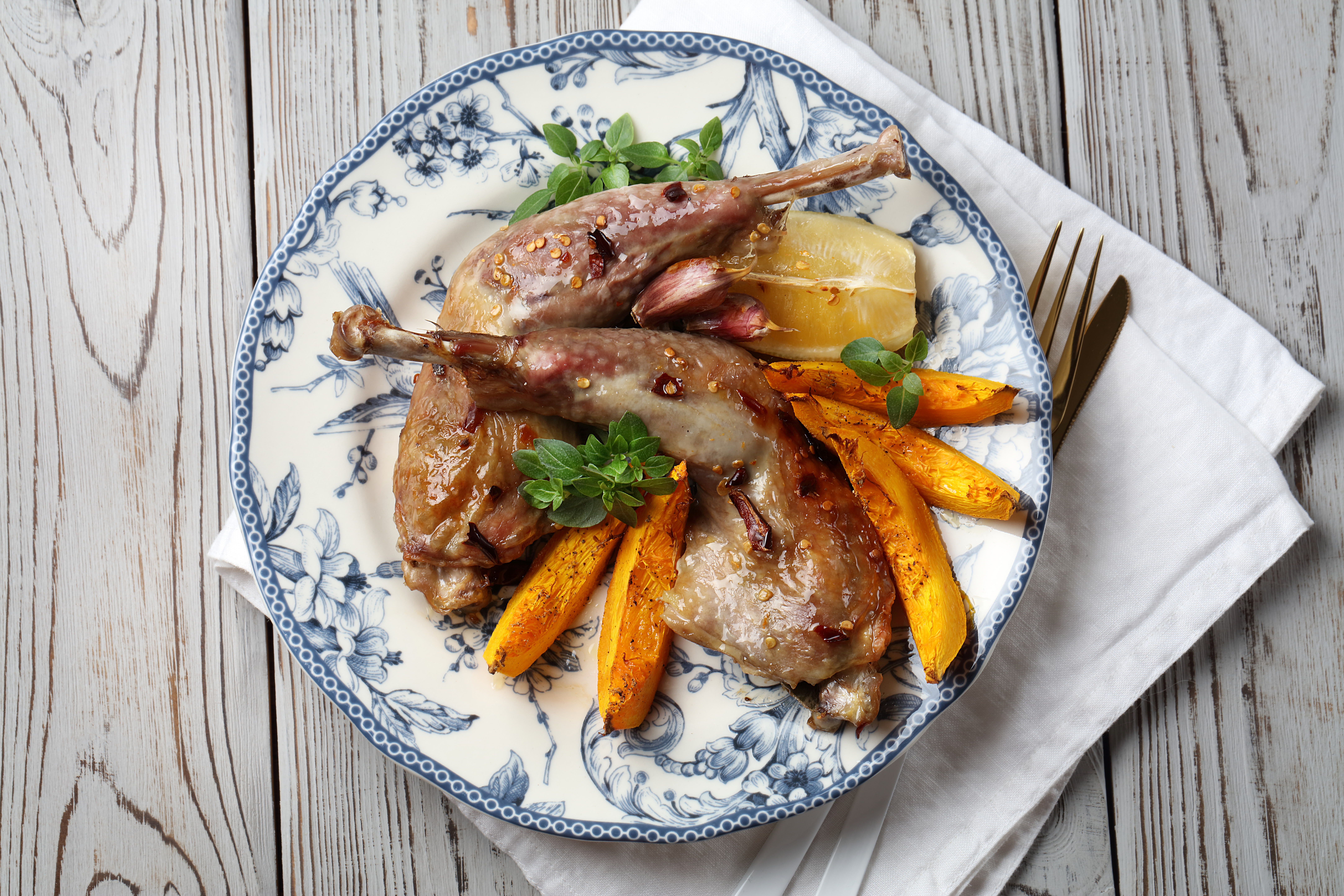
Roasted guinea fowl with pumpkin, lemon, hot pepper, garlic, and basil.
If you would like to try guineas before you butcher your own, you can find frozen guinea fowl online from several meat and charcuterie stores. There are also some local markets that carry unusual birds in their freezer section.
Guinea meat has less fat than chicken, so you may need to brine the bird before cooking. You can also add fat by wrapping the carcass with bacon or some other fat can help keep it from drying out. Slow cooking and Instant Pots also help cook a tasty guinea.
Older cookbooks such as Rombauer’s Joy of Cooking include guinea fowl in the Game section. There are two recipes that will also work for pheasant and chicken. You can also find recipes on foodie websites like BBC Good Food or poultry focused websites such as Poultry Keeper.
Yummy Eggs
Egg laying is seasonal from April to October. Guinea hens may be quite secretive and are skilled at concealing their nests.
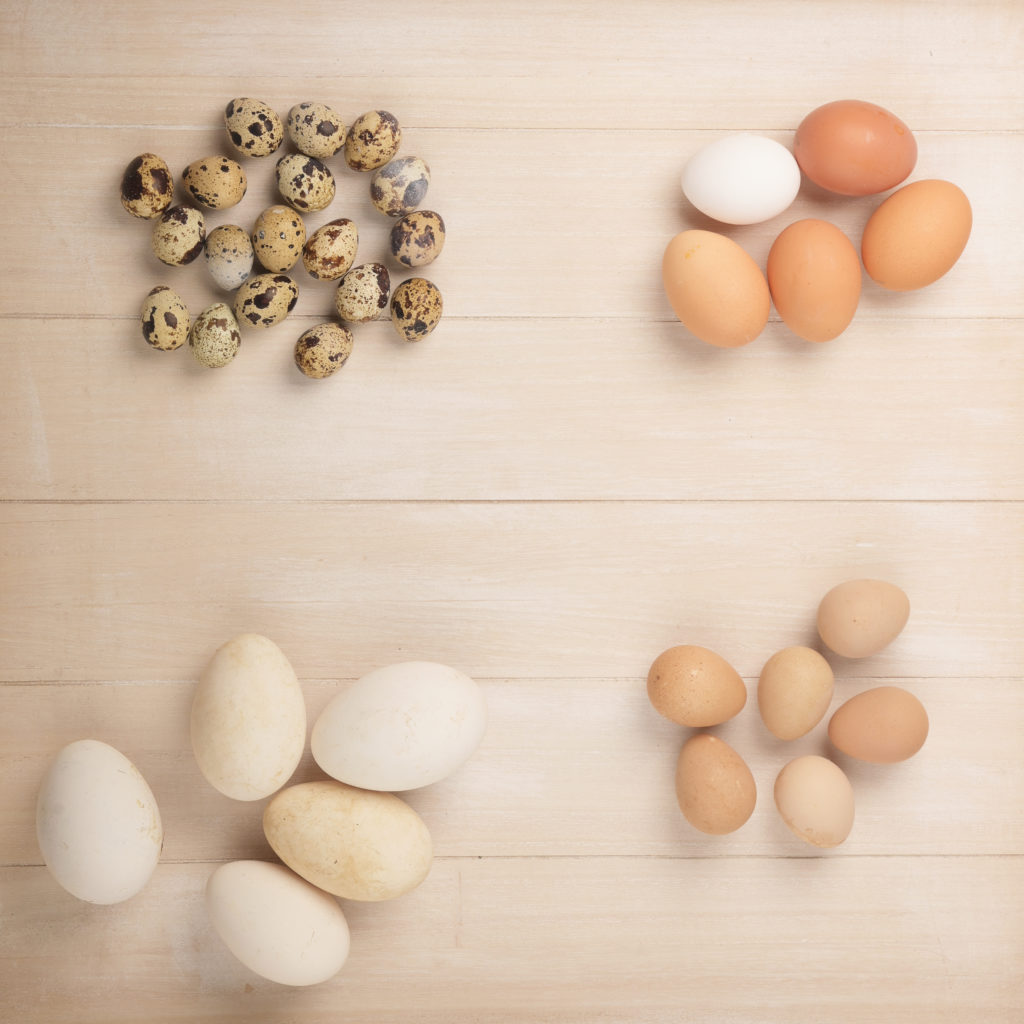
Starting at the top left
Quail, chicken
Goose, guinea fowl eggs
Eggs are similar in flavor to chicken eggs, but smaller. Calculate two guinea eggs to equal one large chicken egg, with slightly more yolk proportionately. The eggs are substantially richer than chicken eggs in both protein and fat. Chicken eggs average 12 percent protein and 6 percent fat while guinea eggs average 13 percent protein and the yolks contain 32 percent fat. Both chicken and guinea eggs provide Omega-3 fatty acids.
Feathers
Spotted guinea feathers make them desirable for crafts. There are the small body feathers and longer wing and tail feathers that come in a variety of patterns. Some vendors also dye the feathers, but the natural ones are beautiful all on their own.
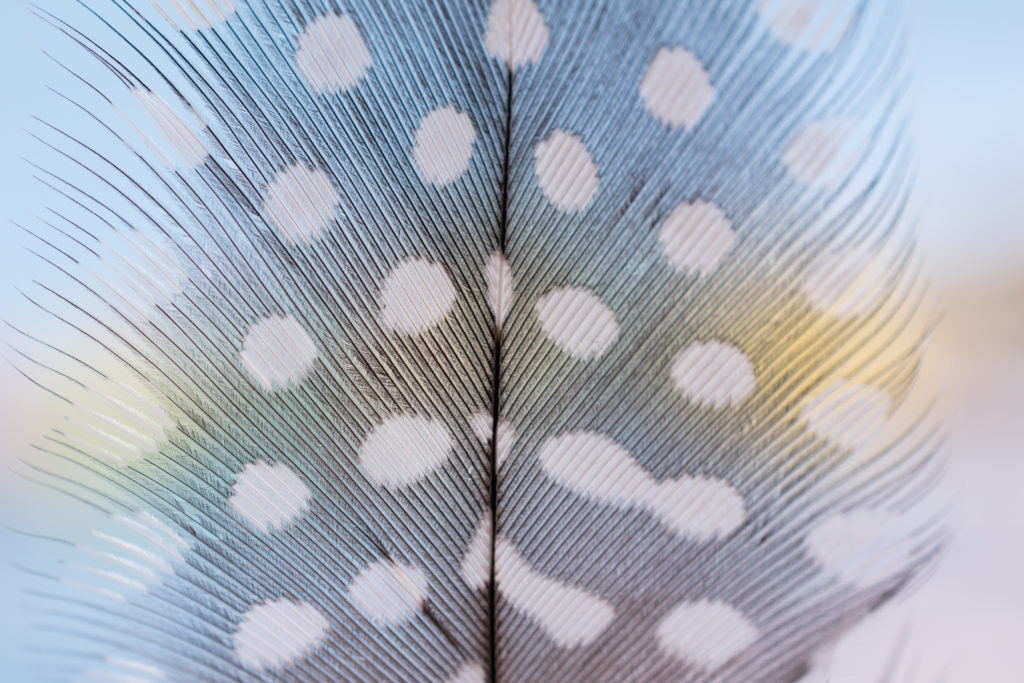
Feather texture soft background for design with space for text
Guinea fowl are fascinating and challenging birds to keep. They are good watch dogs, eat a wide variety of insect pests, and provide both tasty meat and nutritious eggs. Guineas also have strong personalities and wild habits making them more difficult than chickens to train and they free range much more widely.
If you are adventurous, give guineas a try and let them create a sensation on your farm and table.
*****
Christine Heinrichs grew up in northern New Jersey, the New York suburbs. She moved to California in 1967, where she attended the University of California at San Diego and San Diego State University. Christine completed a degree in journalism at the University of Oregon and specialized in science writing. She’s written about a wide variety of subjects, from golf courses to horses. Her work focused on chickens after she wrote How to Raise Chickens, about raising traditional breeds in small flocks, in 2007. How to Raise Poultry followed in 2009. Revised editions were published in 2013 and 2014, respectively. She is a contributing editor to Diversity in Action and has been an elephant seal docent since 2007, after she and her husband moved from Madison, Wisconsin to Cambria. They are both Living History docents at Hearst Castle, dressing up in 1930s finery and decorating the estate for Night Tours. Christine’s work appears in many publications: Earth Island Journal, BioCycle, Community Chickens and others.













11 Comments
Guinea keets are even more susceptible to coccidiosis than chicks are. If you live in an area that gets hot and humid, starter feed with Amprolium (“medicated” chick starter) is recommended, rather than gamebird starter. Another consideration: the recommendation of higher protein starter feed is applicable to keets free-ranging, but for keets kept in a brooder, the extra protein can cause bone damage (varus-valgus) from fast growth.
Thanks for this tip!
Informative article with knowledgeable facts. However you cannot tell sex by wattles 100%.
They are tricky critters!
It has been about two weeks since putting my two guinea fowls in the coop. I have 8 chickens and 2 guinea fowls, a pearl spotted guinea fowl, and a pearl white guinea fowl they are around 5 to 6 weeks old, and had their first fight today, and they were not ending the fight either, so my family and I decided to separate the pearl white guinea from the rest and put her with one of her ‘childhood friends’ the black australorp. What should I do now if they continue to fight?
Guineas are tricky. They aren’t like chickens in several ways: they like to range further, and they will pick on chickens, and they like to pick fights. In someways, you might need to get more guineas so that they have a bigger group to pal around with. If you want to stick with just the two, you might need to keep them separated permanently. Or… let them fight it out to determine dominance. Sound harsh, but something to consider.
I have 8 chickens and two pearl guinea hens on is white, and one is spotted. This is week 5/6 and were put in the coop 2 weeks ago. Both of them started fighting today and weren’t stopping, what should I do? I tried splitting them up temporarily, but solitary confinement doesn’t bode well with them. However, the one I put in the cage outside the coop was ridiculously hyper and would scream like there was no tomorrow. I don’t know what to do. What do you suggest?
I met a woman who keeps her chickens and Guinnea fowl together, 20 or so of each I think. They have an electric predator fence around them which gets moved regularly to follow the the horses in pasture. She said that the guinnea fowl are so pack oriented that if one escapes the enclosure, it frantically tries to get back in to reunite with the flock.
I surely do want to replace my chickens with guinnea girls so that I can let them free range without sacrificing my flower beds or my husbands vegetable gardens. But I am steadfast about wanting them to come home every night.
What to do?! Undecided.
Perhaps if I have raise baby chicks AND guinnea Keats together, they will want to stay near their fair feathered friends.
Guineas are pretty stubborn and really like to range over a pretty big territory. As well as raising them with chicks, you might also try clicker training combined with treats. Here’s an article and video that may help. Best of luck!
https://www.communitychickens.com/clicker-training-for-chickens/
can you keep them with chickens — same coop??
You can. You might have some squabbling and some of the guineas might pick on your chickens. The guineas are much more innovative at escaping as they really love to wander.